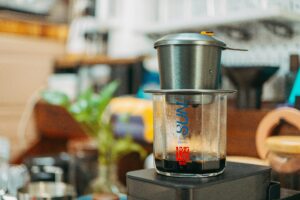As climate awareness continues to rise, coffee drinkers are rethinking the environmental impact of their daily brew. One of the biggest debates in sustainable coffee culture today is between coffee pods and ground coffee. Which one is truly better for the planet?
Table of Contents
In 2025, manufacturers have made strides in both areas to reduce waste and carbon footprints. But even with innovations like compostable pods and ethically sourced beans, not all coffee habits are created equal.
In this guide, we break down the environmental pros and cons of coffee pods vs. ground coffee, so you can brew more consciously.
What Do We Mean by Sustainability?
Sustainability in coffee production includes:
- Carbon footprint (energy and emissions involved in growing, processing, transporting, and brewing)
- Packaging waste (especially plastic and aluminum)
- Water and land use in farming
- Impact on ecosystems and biodiversity
- Waste management and disposal after brewing
Now let’s explore how pods and ground coffee compare in each area.
Coffee Pods: Convenience at a Cost?
Coffee pods (also known as capsules) have become extremely popular due to their speed and consistency. With a single-serve pod, you get the exact dose of coffee with minimal mess. But the environmental trade-offs have long been debated.
Environmental Pros of Coffee Pods
1. Less Water and Coffee Waste
Pod systems are very efficient. You use only the amount of coffee and water needed per cup, which reduces waste compared to brewing a full pot and tossing leftovers.
2. Energy Efficiency
Pod machines often heat water on demand and brew in seconds, using less electricity than traditional drip machines or espresso setups.
3. Emerging Sustainable Designs
In 2025, more companies are creating biodegradable, compostable, or recyclable pods. Brands like Nespresso have even implemented pod recycling programs, though user participation remains low.
Environmental Cons of Coffee Pods
1. Packaging Waste
Traditional pods are made from a mix of plastic, aluminum, and foil, which are often non-recyclable or end up in landfills due to improper disposal. Even when recyclable, many users don’t go through the hassle.
2. High Production Footprint
Manufacturing pods involves energy-intensive processes. It also requires additional resources for packaging, transportation, and disposal.
3. Recycling Challenges
Most municipal recycling systems don’t accept coffee pods unless they’re emptied, cleaned, and sorted—which most people don’t do regularly.
Ground Coffee: More Effort, Less Impact?
Ground coffee is the traditional brewing method, whether via French press, pour-over, or drip machine. While it takes more time and cleanup, ground coffee typically comes with fewer packaging concerns and a lower environmental footprint—when brewed consciously.
Environmental Pros of Ground Coffee
1. Less Packaging Waste
Ground coffee is usually sold in recyclable or paper-based bags, and bulk options reduce packaging per serving. There are even refillable containers in zero-waste grocery stores.
2. Compost-Friendly
Used coffee grounds can be composted at home or added to garden soil. Unlike pods, they decompose naturally and return nutrients to the earth.
3. Customizable and Efficient
Brewing methods like pour-over, French press, or AeroPress allow you to control the amount of water, heat, and coffee used, optimizing both energy and flavor with little waste.
Environmental Cons of Ground Coffee
1. Water and Energy Usage
Brewing a full pot when you only drink one cup can waste coffee, electricity, and water. Electric coffee makers left on for warming also consume more energy.
2. Inconsistent Sourcing
If you’re not buying ethically or organically grown beans, your coffee may contribute to deforestation, pesticide pollution, and low labor wages.
3. Requires More Effort
People often choose pods because they’re quick and easy. Manual brewing with ground coffee requires time, tools, and cleanup—which can be a barrier to sustainable daily habits.
A Lifecycle Comparison: Which One Wins?
Carbon Footprint Per Cup
Studies suggest that single-use pods can have a lower carbon footprint per cup than traditional brewing methods—if used efficiently and disposed of properly. That’s because traditional methods often involve over-brewing, leading to wasted coffee and energy.
However, this advantage disappears if pods aren’t recycled or if consumers brew multiple pods daily, increasing waste.
Waste Generation
- Pods: Can generate 10–15 times more packaging waste per cup if not compostable or recyclable.
- Ground coffee: Minimal packaging waste, and spent grounds are compostable or reusable (in beauty products, gardening, etc.).
The Rise of Eco-Friendly Pod Alternatives
In response to consumer demand, 2025 has seen a wave of sustainable pod options:
- Compostable coffee pods made from cornstarch or paper
- Reusable stainless steel pods you can fill with your own ground coffee
- Brand-led recycling programs with pre-paid return bags
While these solutions are promising, they require consumer commitment to sorting, cleaning, and returning used materials—something not everyone is consistent with.
The Final Verdict: Which Is More Sustainable?
Ground Coffee Wins—With Conscious Brewing
If sustainability is your top priority, brewing ground coffee with minimal waste, composting your grounds, and sourcing beans ethically makes it the most eco-friendly choice.
However, pods can compete in sustainability—only when they are:
- Made from compostable or recyclable materials
- Used with high-efficiency machines
- Recycled properly or reused in refillable form
So, the better question may be: how sustainable is your coffee habit, not just your coffee format?
Tips for a More Sustainable Coffee Routine
- Buy organic, shade-grown, or Fair Trade coffee
- Compost your grounds or pods (if compostable)
- Use a reusable filter or stainless steel pod
- Brew only what you need
- Choose brands with transparent sustainability practices
- Support local roasters with low-impact packaging
Final Thoughts
There’s no one-size-fits-all answer. Both coffee pods and ground coffee can be part of a sustainable lifestyle—depending on how they’re sourced, brewed, and disposed of.
If convenience is critical, invest in compostable or reusable pods. If flavor, ritual, and low waste matter more, grind your own beans and compost the leftovers.
Ultimately, sustainability comes down to daily choices. From what you brew to how you discard it, every cup has an impact. Brew smart, waste less, and enjoy your coffee knowing you’re making a better choice for the planet.








